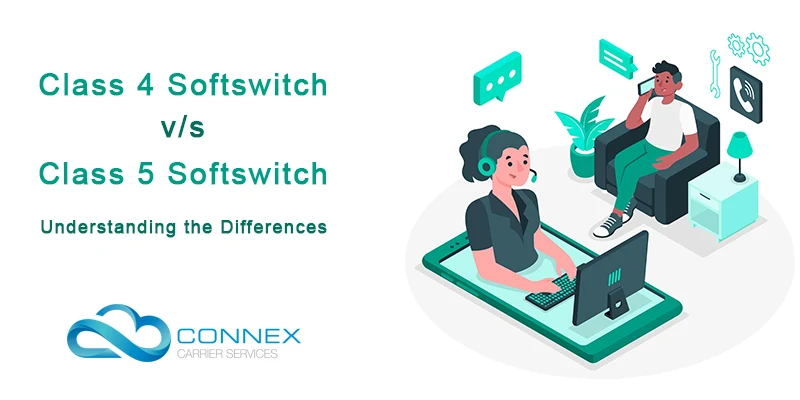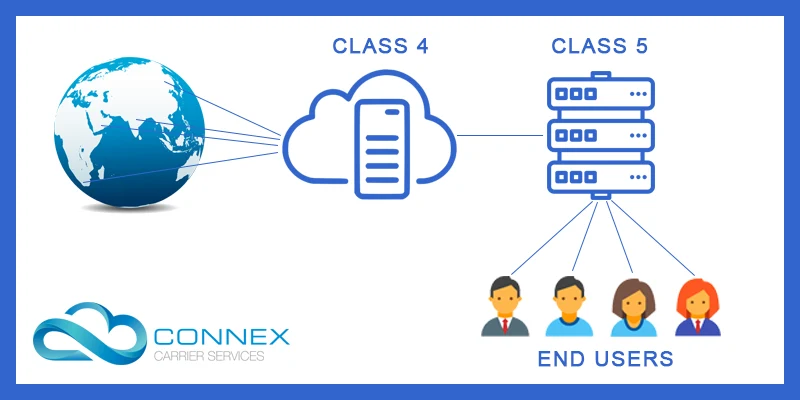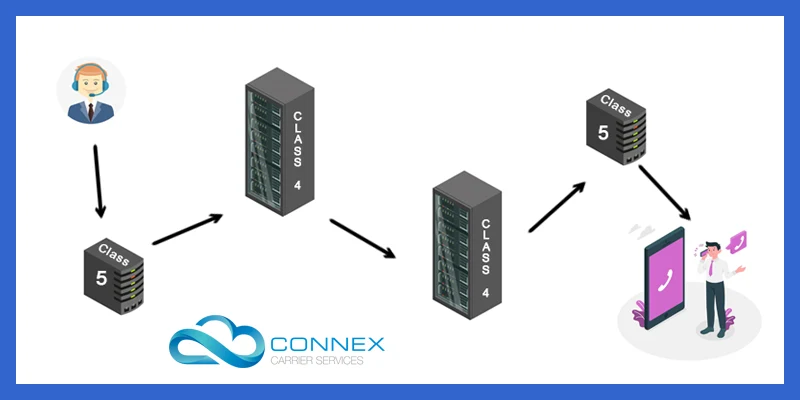Class 4 Softswitch vs Class 5 Softswitch - Understanding the Difference

Call switching required special equipment and infrastructure before the introduction of VoIP. However, the fundamental nature of VoIP meant you could conduct call switching functions using the regular computing infrastructure.
This severely reduced the costs and complexities associated with call switching. The resulting low cost of entry increased the competition in the telecom industry.
What did this mean for the end consumer? Higher audio quality, easy and low latency connectivity and easy communications across the globe at affordable rates.
At the core of this revolution were two pieces of technology. The Class 4 Softswitch and the Class 5 Softswitch. Besides industry professionals, not many know the difference between the two.
So if you’re someone trying to understand the difference between the two to choose the right solution for your needs, you’re in the right place.
So let’s get started, shall we?
What is a Softswitch?
A Softswitch is a combination of the words software and switchboard. A Softswitch is an integral part of a VoIP telecom network that manages and routes voice traffic from its source to its destination.
A Softswitch can route a call within the traditional telecom network or use public internet and Softswitches based on it to route a call to its destination.
If that was too technical for you, let me explain it to you in a better way. You must have seen how calls used to be made back in the early days of the telephone from the movies right?

So, to connect the caller to the person he wanted to talk to, a telephone operator had to physically connect a wire on the switchboard from the caller’s line to the destination line.
The switchboard you see above is a physical representation of all the telephone lines. The process of connecting the caller to the destination is known as call switching.
Today, you don’t have telephone operators switching calls manually. Instead, you have software running on capable servers that perform the same task in an instant over the internet.
I hope by now you have a clear understanding of what a Softswitch is. We can now continue and understand what the Class 4 Softswitch and Class 5 Softswitch are!
What is a Class 4 Softswitch?
A Class 4 Softswitch is a wholesale solution used to route large traffic of IP to IP calls over long international distances.
It is capable of handling large VoIP traffic between and over different carriers, exchanges and Public Switching Telephone Networks (PSTNs).
A Class 4 Softswitch solution is the best option for a carrier looking to route large traffic of VoIP calls over long distances at affordable prices.
Enterprises that require similar communication capabilities with their clients, employees, and customers based in far-off locations can also benefit tremendously from it.
Let’s consider an example here.
A US-based company is looking to expand its operations into the Middle East. They have staff working from home as well as staff working on the field.
With correct class 4 switching, they can place calls to their colleagues' extension and it will always reach them most effectively and efficiently. All of this is possible without having to rely on external companies to do it for them.
Now you know what a Class 4 Softswitch does, let's continue and understand what a Class 5 Softswitch does!
What is a Class 5 Softswitch?
To put it simply, a Class 5 Softswitch enables you to place and receive calls and can deliver applications such as voicemail and conference bridges. It enables connections between a phone and the class 5 switch.
A Class 4 Softswitch routes a call from its origination to the right IP address, SIP address or DID number. In case of a long-distance call, it routes the respective call through a Class 4 Softswitch to its destination.
In terms of traffic throughput, a Class 5 Softswitch has a greater operational overhead than a Class 4 Softswitch.
However, as the Class 5 Softswitch is end-user-focused, it offers features and functionalities that are desired by the end-users.
A Class 5 Softswitch offers features such as basic dial-tone, IP PBX features, calling features, call center features and services, calling card platform, QoS, conference calls, Interactive Voice Response and many more.
Now let’s consider an example.
A business wishes to have some level of automation when someone calls in, give them a menu to choose what department they wish to be routed to, or allow them to join in a conference room with other users.
Because a class 5 switch can answer a call, play audio and merge audio it is the right solution for the company.
I hope you now understand what a Class 5 Softswitch is. Now let’s pit them against one another and understand the differences in depth.
What are the Differences between a Class 4 and Class 5 Softswitch?
To understand the differences properly, I shall list them in different categories.

Intended User
A Class 4 Softswitch is intended to be used by carriers and large enterprises for routing large VoIP traffic.
A Class 5 Softswitch is intended to be used by a firm for routing internal and external communication.
Traffic Throughput
By design, a Class 4 Softswitch is capable of handling a large throughput of VoIP traffic. Consider ConnexCS’s example, as our Class 4 Softswitch is cloud-based, in theory, it is infinitely horizontally scalable as per client requirements.
A Class 5 Softswitch by design is not capable of handling the similar amount of VoIP throughput that a Class 4 Softswitch can, sharding is generally a better scaling approach.
However, a Class 5 Softswitch has enough throughput to handle communications of enterprises of all sizes.
Features
The basic difference in the features offered by the two is the nature of those features.
A Class 4 Softswitch offers features that are carrier, telcos and VoIP solution provider-centric whereas a Class 5 Softswitch offers features that are end-user-centric.
A Class 4 Softswitch offers features like:
- Protocol support and conversion
- Several concurrent calls
- Transcoding
- Intelligent call routing
- Secured firewall
A Class 5 Softswitch offers features like:
- IP PBX
- Calling card platform
- Conference Bridges
- Interactive Voice Response

I'm sure that now you completely understand the difference between a Class 4 and Class 5 Softswitch. Wondering who can provide you with these solutions? ConnexCS can!
ConnexCS’s Class 4 Softswitch
We’re one of the top Web 2.0 Cloud-based Class 4 Softswitch solutions providers in the world. What does this mean for you?
Quick Scalability - Being cloud-first allows us to quickly adapt to your changing requirements, not just locally but globally. Be it rapid upscaling or downsizing operations, ConnexCS will make sure you always have the right throughput.
Ease of Use - Unlike other providers, our products are built on Web 2.0. This means you no longer have to operate dashboards that not only look ancient but function similarly.
Realtime Support - You won’t have to deal with chatbots or recorded audio for troubleshooting. Our customer support executives will be always available to help you out with all difficulties you may face.
Dedicated IP Addresses and Servers - Tired of high latency and call drops? We offer dedicated IP addresses so you won’t have to share your network with anyone.
You get to choose from servers that are closest to your operational areas. So say goodbye to high latency and call drops.
Speaking of high up-time, ConnexCS is the only Softswitch as a service to offer Anycast loadbalancers.
Meaning that we can scalably distribute traffic to all of your SIP Servers without a single point of failure. We can even tolerate data center outages effortlessly.
ConnexCS’s Class 5 Softswitch
An easy-to-use and deploy Class 5 PBX like none you’ve experienced before. Similar to our Class 4 Softswitch, there are many benefits to using our Class 5 Softswitch as well.
Easy to Deploy - As all our solutions are cloud-based, they can be deployed quickly and scaled as per your requirements.
Ease of Use - You’ll enjoy a modern interface that is easy to navigate around, set up and use features and effortless to troubleshoot.
Calling Strategies/Rules - You have complete control over how calls are routed, which users have access to what numbers, internal and external communications, etc.
Countless Features - Conference bridges, Interactive Voice Menus, Voicemails, Hunt Groups, Call Queuing, Programmable Voice and many more.
Ending Notes
Handling and managing communications is integral for any carrier, telco or large enterprise. In order to have effective communication, it is necessary to understand your requirements and find the best solution for them.
ConnexCS hopes this article helps you in understanding how a Class 4 and Class 5 Softswitch caters to different communication requirements.
With this knowledge, we’re sure you’ll be able to find the right solution for your needs!
























































































































